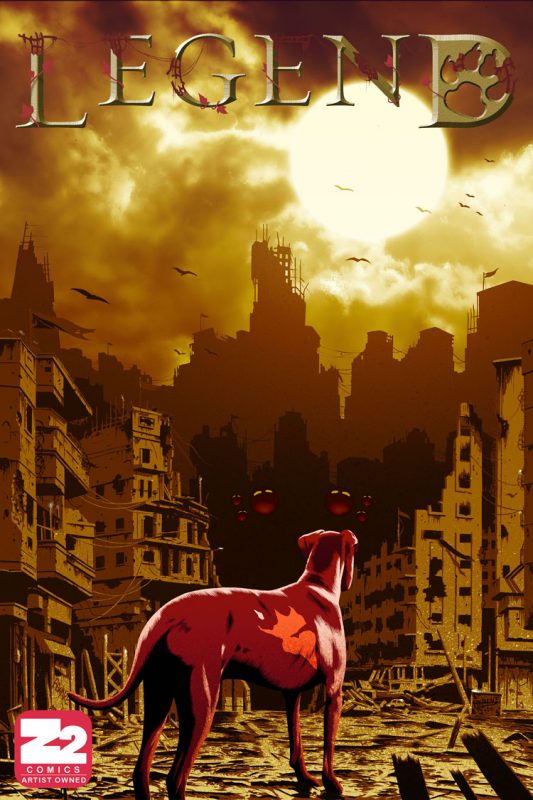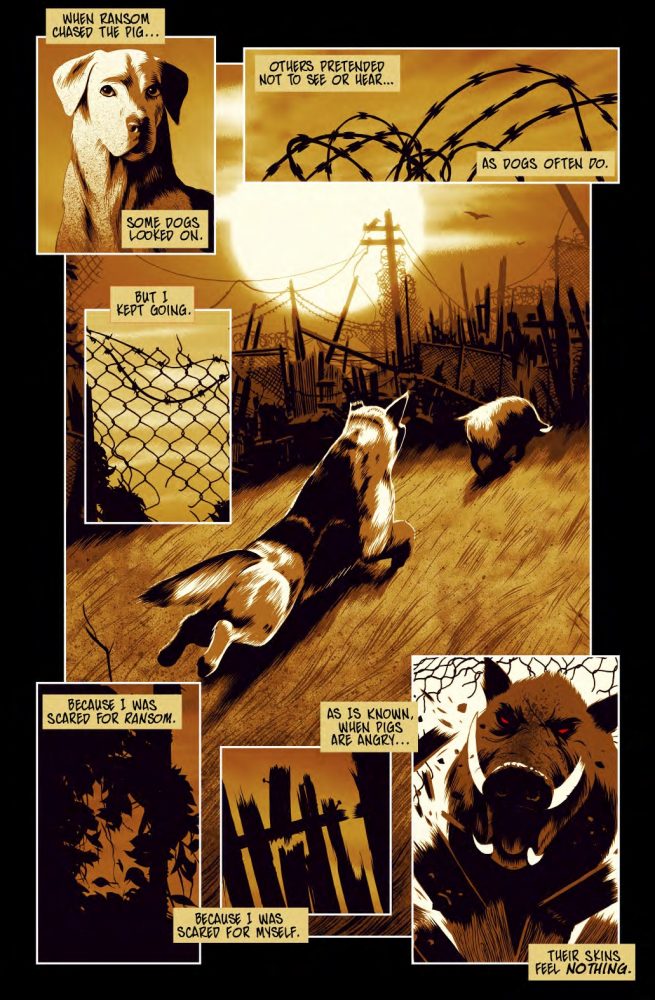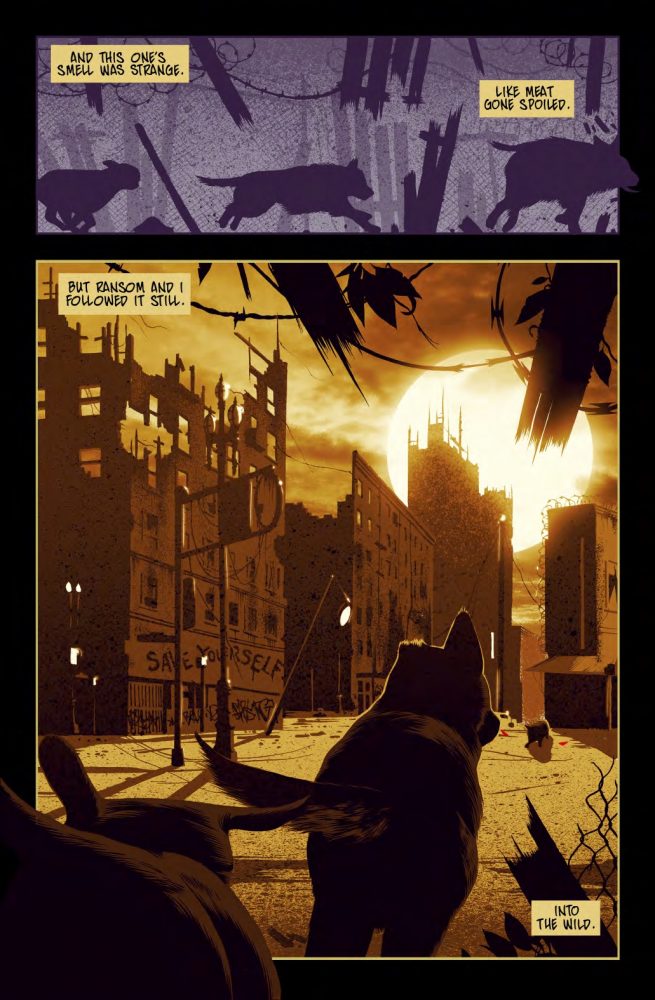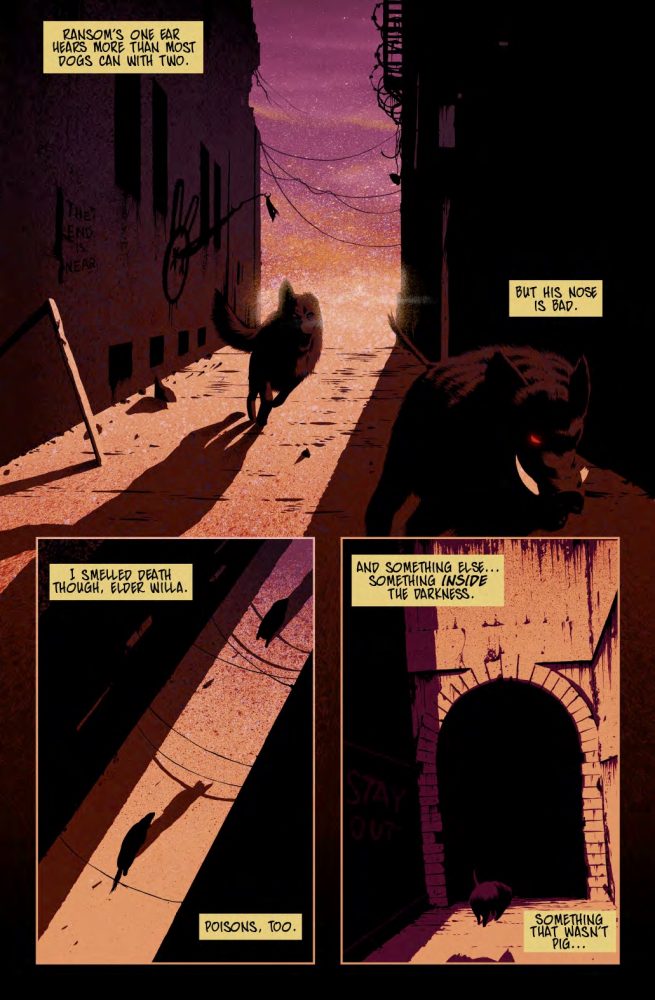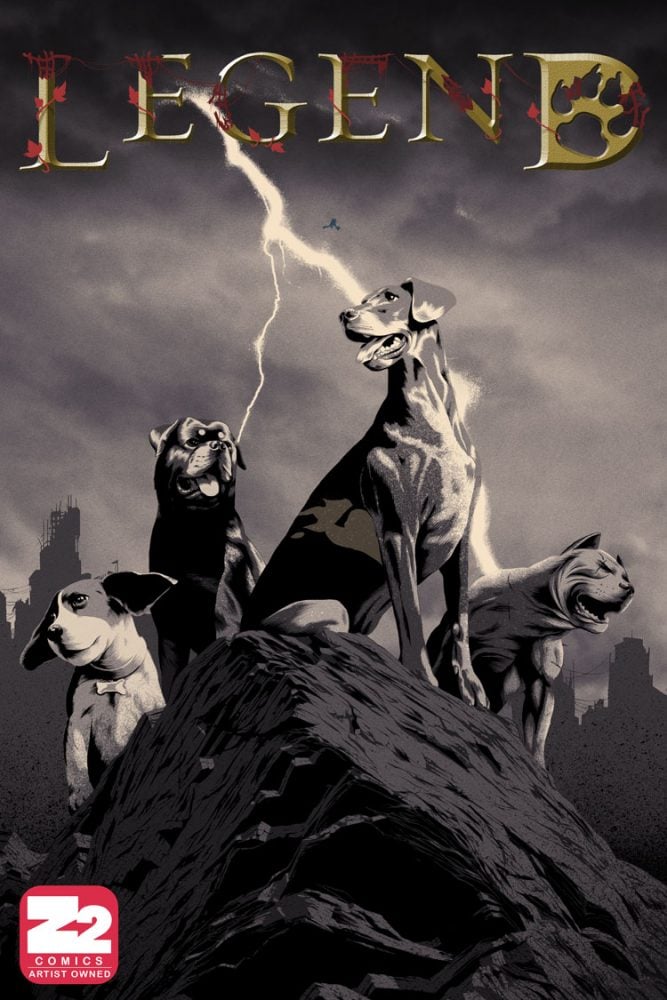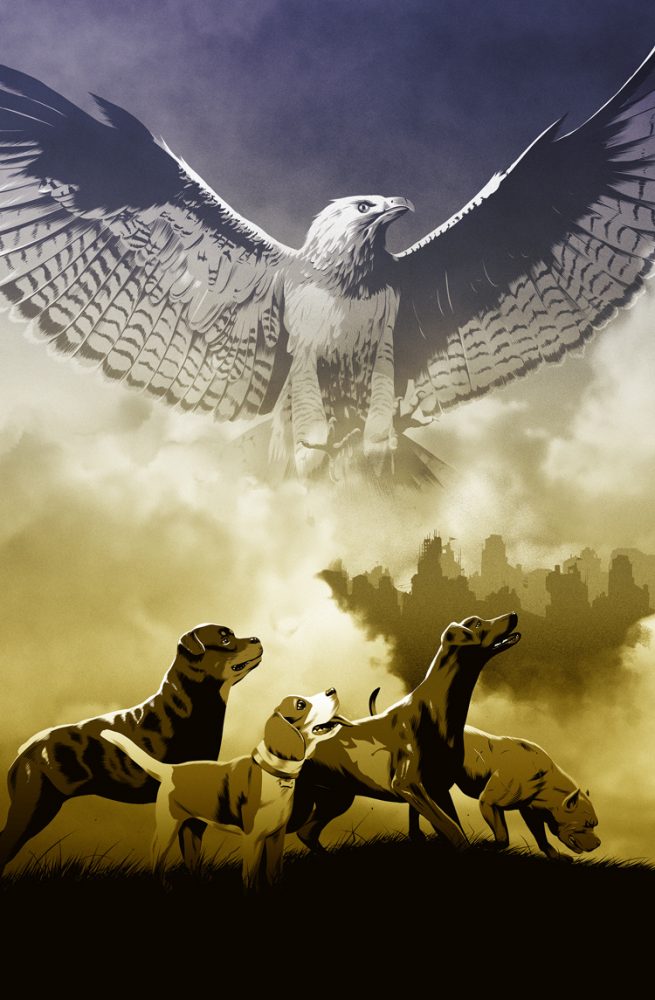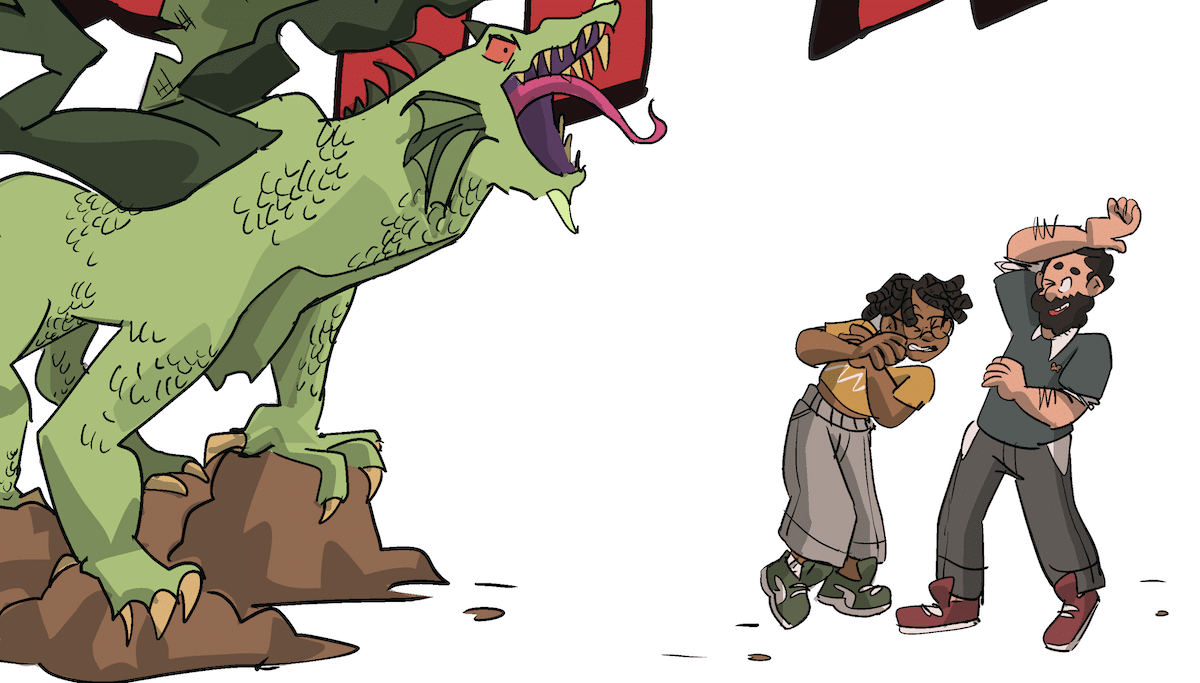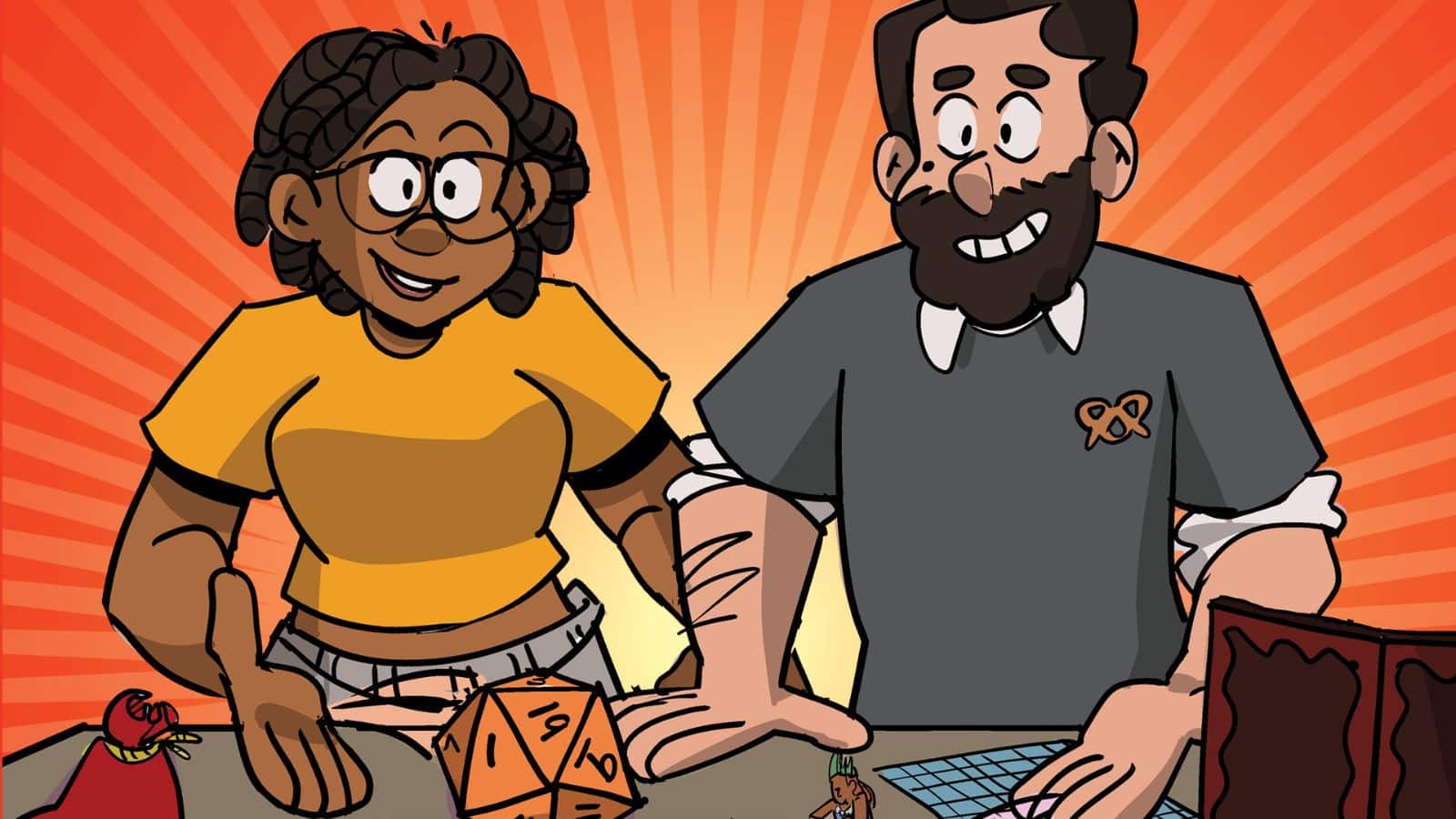Z2 Comics might not be the biggest or most recognized comic book publisher, however that could change soon. With lightning in a bottle titles like Welcome to Showside and Henni, they are proving to be one of the most diverse publishers in the industry. This week sees the debut of Legend from the creative team of novelist Samuel Sattin (The Silent End, League of Somebodies) and award-winning artist Chris Koehler. Legend takes readers into a dystopian world left to the animals by man’s own fault. It’s a world of ugly hierarchies mirroring tribes of past civilizations while inversely expressing a powerful beauty in these pages.
Will the reluctant leader dog known as Legend become what he was meant to be and lead his pack against the unknown murdering menace called the Endark? The only sure thing is one epic comic book story is about to unfold.
The Comics Beat was lucky enough to get a few answers to pressing questions from novelist Sam Sattin.
David Nieves: For those who haven’t heard of it. What’s the story of Z2 Comics Legend about?
Sam Sattin: I always like to describe Legend as a mash-up of Watership Down and The Walking Dead, with cats and dogs instead of rabbits, and horrific creatures that roam the night. But at its core, the story is one of dogs (and cats) attempting to rebuild a world humanity destroyed, while being terrorized by pernicious forces.
Nieves: When I first heard about the comic I immediately drew comparisons to Brian K Vaughn’s Pride of Baghdad. After reading this first issue, Legend has a powerful and distinct narrative. Can you tell us a bit about what inspired the story?
Sam: What an incredible compliment! I love Pride of Baghdad, and Legend is indeed inspired by it. One thing I like about Pride in particular, and that I think carries over into what we’re doing, is the idea that animals (and nature in general) are victims in humanity’s constant war over resources and land.
In terms of inspiration, I’ve always been fascinated by animal stories. I find they can carry a lot of symbolic weight, and are fertile ground for allegory. I grew up reading (and being frightened by, to be perfectly honest) books likeWatership Down, Where the Red Fern Grows, Animal Farm, and the Redwall series. And each has stuck with me. I have vivid memories of Napoleon and Snowball, of Fiver and Bigwig, of Mattimeo and Martin the Warrior and many, many more. Seeing Princess Mononoke as an adult pushed me over the threshold, and I decided that one day I wanted to make an animal story of my own, even if I wasn’t sure what kind it would be, or whether I’d be able to do it successfully. I’m a big reader of science fiction and horror, and when thinking about what I might be able to add to the tradition of animal stories, I turned towards a ravaged earth. We3 by Grant Morrison helped me along that path, I think, as it does a spectacular job of remixing modern genre elements with animal stories of old.
Nieves: I noticed you chose to not have the title character be primary focus of the first issue. Why did you choose to open this story from a POV other than the protagonist’s?
Sam: That’s a really great question. There’s a lot of stage-setting involved in Legend. The world in which it takes place, an earth where humanity has fallen is large, frightening, and multifaceted, as are the dynamics between members of the Dog Tribe, and their neighbors, the Cat Tribe. At the beginning of the book, the leader of the Dog Tribe has been killed by a terrible monster called the Endark, and I had to consider what would be the best way to recount that harrowing tale, while simultaneously setting up other narrative threads and world building.
I also wanted to make sure that we didn’t give away too much too quickly. If Legend (the main character) were to have been the one to witness the leader of the Dog Tribe be murdered, then the monster itself, upon which much of the story relies, may have received a little too much exposure. This way, our protagonist, along with the reader, gets an impression of the threat in store, without receiving too much information. Also, it was a great opportunity to introduce Fidget, which is a secret favorite character of Chris and myself.
Nieves: The book’s supporting cast such as Fidget have so much complex human emotion that it’s hard not to immediately find something to root for in these pages. You do some of the best anthropomorphizing in comics since Pride of Baghdad. What do you see as common trait between animals and humans? As a writer, is there a different way of thinking for you when it comes to projecting human traits on animals?
Sam Sattin: Well, now I’m blushing. I simply love the way that Vaughan anthropomorphizes his animal characters in Pride of Baghdad, and one of my personal goals as the writer of Legend is to try and create a similar experience.
Animals and humans have something strange in common. I don’t think we share the same emotions—animals don’t appear preoccupied with existential matters that drive humans into troublesome situations. But what we do have in common is that we’re territorial, that we’re tribal, and that we see certain outsiders as friends and foes.
Nieves: There’s hints of so many layers to this world. How far have you mapped out this story? When can we expect to see the cat kingdom or learn about what happened to mankind?
Sam: The world in which Legend takes place (which our animals refer to as The Land) is huge, beautiful, and mysterious. Along with comprehensive plot building, Chris and I have put alot into the physical construction of the world as well. We actually have a great artist working on a map at the moment that reveals more of itself at the end of each issue, as the dogs (and cats) venture out. In terms of our story arc, we have a full one at the moment with a resolution clearly in mind, but we’re also not discounting the possibility for continuation.
You’ll learn quite soon what happened to mankind—as early as issue two…at least in bits of pieces. Issue two also offers an introduction to the Cat Tribe and their arcane technology that, with hope, you won’t soon forget.
Nieves: Could you tell us how you were paired up with artist Chris Koehler on the book?
Sam: Though to wrangle that kind of brilliance I’d like to say that I’m extorting his family, Chris was actually my illustration professor in the California College of the Arts MFA in Comics program. The guy draws like a maniac, and is a veritable wellspring of technical and aesthetic knowledge that reaches beyond human capacity.
Chris and I started to pitch ideas back and forth in late 2014, and after we took Legend to the table, it was the one that stuck. We work really well together. He’s a brilliant guy. We see eye to eye on most everything, and yet, consistently surprise each other, being that we bring different perspectives to the table. We also come to this project with different backgrounds—Chris, as an illustrator, and myself as a novelist—and those backgrounds inform our approach to Legend, as the story unfolds.
Nieves: Every panel he does in the book looks exquisite enough to be hanging in a fancy art gallery. When you flip through these pages, it’s noticeable that you almost go out of your way to let the art tell the story on its own. Was letting the art breathe something you envisioned all along or was that a decision you came to later on? Being a novelist did you find it difficult to keep the amount of words in the book streamlined?
Sam: Yes, yes, and then yes again. Writing comics has probably been the hardest (and most valuable) thing I’ve done in my writing career, not to mention it’s been extremely beneficial to me as a novelist. I’ve had to learn to not only accommodate economy of language, but to let the images shoulder as much, if not more, than the words themselves. Chris’s images carry so much of the story, and they are gorgeous, as you say, to the extent of being gallery worthy, where Chris’s work is often shown. I’ve come to realize now that a lot of writing in comics is done off the page. Long form prose is so different in that regard—everything is riding on words and words alone. In comics, if you’re too focused on prose, everything comes to a halt and you have a tendency to alienate the reader.
Nieves: Do either you or Chris have pets you modeled these characters after?
Sam Sattin: Chris hates all of god’s creatures (well, maybe not all of them). But yes, I have pets, and the animals in Legend are very much based many I know and love. Elsa is based loosely on my mother’s beagle, Dolly, who we inherited from her after she passed away, supplemented with added reference from a friend’s beagle. Our cat characters that have yet to introduce are modeled on my pets as well. Legend himself, along with Herman, is based directly our friends’ dogs. Chris and I took hundreds upon hundreds of reference pictures of in order to make sure we could bring this story to life.
I should also mention that we’ll be folding in more animal cameos as we proceed, including some of my publisher’s dog! We’ve been approached by quite a few people asking that their pets make it into our pages, and some readers may see even see theirs immortalized therein. But I should also warn that the world the dogs of Legend inhabit is quite dangerous, so readers should be careful what they wish for…
Nieves: Which do you prefer to write, novels or comics? What was your first comics reading experience?
Sam: To sound perfectly unreasonable, I think I prefer both…just in different ways.
Nieves: Even the barrier the two mediums have between them?
I think novelists can learn a lot from comics. The medium itself is so dynamic and fascinating that to get behind the scenes is nothing short of revelatory. It’s also deceivingly difficult, which is something a lot of people simply don’t understand. Novels, on the other hand, are like a baby blanket to me. They’ve always been such a mainstay in my life, that writing them is something I need to do to feel right with the world. That said, I oscillate back and forth. Comics are too exciting right now not to be a cackling loon about.
My first comics reading experience was in middle school. I discovered an old stack of Chris Claremont Wolverine comics and became obsessed, as one might expect. Now, I’m just sucked into the world of contemporary comics, and I’m just unbelievably honored to on the Z2 lineup this year, alongside so many other fabulous books. It’s really amazing to see, and I’m thrilled to be part of it all.
Nieves: Hey! When I was in middle school, Claremont was my first exposure to comics back in the early 90’s with Jim Lee on X-Men. I think we just became Martha Besties!
If you like post apocalyptic worlds, intriguing suspense stories, or your life is already ruled by dogs and cats on the internet then Legend is THE comic not to be missed when it lands in stores this Wednesday. You should also check out more of Samuel Sattin’s work available on Amazon; if you can find it League of Somebodies is a fantastic read .
Also, Z2 is letting little old Beat be the first to show you this majestic cover to LEGEND #4 that proves not only should Chris Koehler be nominated for an Eisner next year, but he also loves this country more than you.


